
Edward Whymper
Encyclopedia
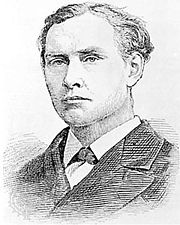
Edward Whymper was an English
England
England is a country that is part of the United Kingdom. It shares land borders with Scotland to the north and Wales to the west; the Irish Sea is to the north west, the Celtic Sea to the south west, with the North Sea to the east and the English Channel to the south separating it from continental...
illustrator, climber
Mountaineering
Mountaineering or mountain climbing is the sport, hobby or profession of hiking, skiing, and climbing mountains. While mountaineering began as attempts to reach the highest point of unclimbed mountains it has branched into specialisations that address different aspects of the mountain and consists...
and explorer best known for the first ascent
First ascent
In climbing, a first ascent is the first successful, documented attainment of the top of a mountain, or the first to follow a particular climbing route...
of the Matterhorn
Matterhorn
The Matterhorn , Monte Cervino or Mont Cervin , is a mountain in the Pennine Alps on the border between Switzerland and Italy. Its summit is 4,478 metres high, making it one of the highest peaks in the Alps. The four steep faces, rising above the surrounding glaciers, face the four compass points...
in 1865. On the descent four members of the party were killed.
Early life
Edward Whymper was born in LondonLondon
London is the capital city of :England and the :United Kingdom, the largest metropolitan area in the United Kingdom, and the largest urban zone in the European Union by most measures. Located on the River Thames, London has been a major settlement for two millennia, its history going back to its...
, England
England
England is a country that is part of the United Kingdom. It shares land borders with Scotland to the north and Wales to the west; the Irish Sea is to the north west, the Celtic Sea to the south west, with the North Sea to the east and the English Channel to the south separating it from continental...
on 27 April 1840 to Josiah Wood Whymper
Josiah Wood Whymper
Josiah Wood Whymper RI was an English wood engraver, illustrator and painter. Born the son of a brewer, he was apprenticed to a stonemason. He soon turned to drawing and painting, settled in London in 1829 and studied under William Collingwood Smith...
and Elizabeth Claridge. He was the second of eleven children, his older brother being the artist and explorer Frederick Whymper
Frederick Whymper
Frederick Whymper was a British artist and explorer.Whymper was born in London in 1838, the eldest son of Elizabeth Whitworth Claridge and Josiah Wood Whymper, a celebrated wood-engraver and artist...
. He was trained to be a wood-engraver at an early age. In 1860, he made extensive forays into the central and western Alps
Alps
The Alps is one of the great mountain range systems of Europe, stretching from Austria and Slovenia in the east through Italy, Switzerland, Liechtenstein and Germany to France in the west....
to produce a series of commissioned alpine scenery drawings. Among the objects of this tour was the illustration of an unsuccessful attempt made by Professor Bonney's party to ascend Mont Pelvoux
Mont Pelvoux
Mont Pelvoux is a mountain in the Massif des Écrins in the French Alps.For many years Mont Pelvoux was believed to be the highest mountain in the region since the higher Barre des Écrins cannot be seen from the Durance valley....
, at that time believed to be the highest peak of the Dauphiné Alps
Dauphiné Alps
The Dauphiné Alps are a group of mountain ranges in southeastern France, west of the main chain of the Alps. They are separated from the Cottian Alps in the east by the Col du Galibier and the upper Durance valley; from the western Graian Alps in the north-east by the river Arc; from the lower...
. Whymper successfully completed the ascent of Mont Pelvoux in 1861, the first of a series of expeditions that threw much light on the topography of an area at that time very imperfectly mapped. From the summit of Mont Pelvoux, Whymper discovered that it was overtopped by a neighbouring peak, subsequently named the Barre des Écrins
Barre des Écrins
The Barre des Écrins is a mountain in the French Alps, the highest point of the Massif des Écrins, and the most southerly alpine peak in Europe that is higher than 4,000 metres.- Geography :...
, which, before the annexation of Savoy
Savoy
Savoy is a region of France. It comprises roughly the territory of the Western Alps situated between Lake Geneva in the north and Monaco and the Mediterranean coast in the south....
added Mont Blanc
Mont Blanc
Mont Blanc or Monte Bianco , meaning "White Mountain", is the highest mountain in the Alps, Western Europe and the European Union. It rises above sea level and is ranked 11th in the world in topographic prominence...
to the possessions of France, was the highest point in the French Alps. Whymper climbed the Barre des Écrins in 1864 with Horace Walker
Horace Walker
Horace Walker was an English mountaineer who made many notable first ascents, including Mount Elbrus and the Grandes Jorasses.-Alpinism:...
, A. W. Moore
Adolphus Warburton Moore
Adolphus Warburton Moore was a British civil servant and mountaineer.-Life:The son of Major John Arthur Moore and Sophia Stewart Yates,, Moore was an India Office official from 1858–1887, holding the role of Assistant Secretary, Political Department from 1875–1885...
and guides Christian Almer
Christian Almer
thumb|220px|Christian AlmerChristian Almer was a Swiss mountain guide and the first ascentionist of many prominent mountains in the western Alps during the golden and silver ages of alpinism....
senior and junior.
The years 1861 to 1865 were filled with a number of new expeditions in the Mont Blanc massif
Mont Blanc Massif
The Mont Blanc massif is a mountain range in the western Alps. It is named after Mont Blanc, at 4,810.45 m the highest summit of the Alps. It is located in France , Italy , and Switzerland...
and the Pennine Alps
Pennine Alps
The Pennine Alps are a mountain range in the western part of the Alps. They are located in Switzerland and Italy...
, among them the first ascents of the Aiguille d'Argentière
Aiguille d'Argentière
The Aiguille d'Argentière is a mountain in the Mont Blanc massif on the border between France and Switzerland.The first ascent of the mountain was by a British party comprising Edward Whymper and A. Reilly with guides Michel Croz, M. Payot, H. Charlet on 15 July 1864...
and Mont Dolent
Mont Dolent
Mont Dolent is a mountain in the Mont Blanc massif that lies on the border of Italy and Switzerland.It is generally considered the tripoint between France, Italy and Switzerland, although the point itself lies at 3,749 metres, north-west of the summit of Mont Dolent.The first ascent of the...
in 1864, and the Aiguille Verte
Aiguille Verte
The Aiguille Verte is a mountain in the Mont Blanc massif in the French Alps.It was first climbed on 29 June 1865 by Edward Whymper, Christian Almer and Franz Biner, a fortnight before the fateful first ascent of the Matterhorn. Whymper was unable to climb with his usual guide, Michel Croz, who...
, the Grand Cornier
Grand Cornier
The Grand Cornier is a mountain in the Pennine Alps in Switzerland. It lies 2 km north from the Dent BlancheThe first ascent of the mountain was made via the east ridge by Edward Whymper, Christian Almer, Michel Croz and F. Biner on 16 June 1865.The Mountet hut and Moiry hut are used for...
and Pointe Whymper on the Grandes Jorasses
Grandes Jorasses
The Grandes Jorasses is a mountain in the Mont Blanc massif.The first ascent of the highest peak of the mountain was by Horace Walker with guides Melchior Anderegg, Johann Jaun and Julien Grange on 30 June 1868...
in 1865.
That year he also made the first crossing of the Moming Pass. According to his own words, his only failure was on the west ridge of the Dent d'Hérens
Dent d'Hérens
The Dent d'Hérens is a mountain in the Pennine Alps, lying on the border between Italy and Switzerland. The mountain lies a few kilometres west of the Matterhorn.The Aosta hut is used for the normal route.-Naming:...
in 1863.
The Matterhorn
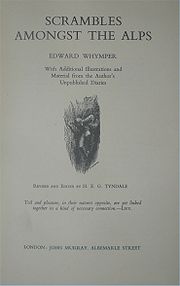
John Tyndall
John Tyndall FRS was a prominent Irish 19th century physicist. His initial scientific fame arose in the 1850s from his study of diamagnetism. Later he studied thermal radiation, and produced a number of discoveries about processes in the atmosphere...
and Whymper emulated each other in determined attempts to reach the summit of the Matterhorn by the south-western, or Italian, ridge. In 1865 Whymper, who had failed eight times already, attempted unsuccessfully to climb a couloir on the south-east face with Michel Croz
Michel Croz
Michel Auguste Croz was a French mountain guide and the first ascentionist of many mountains in the western Alps during the golden age of alpinism...
. After Croz left for a prior engagement with Charles Hudson, Whymper was unable to secure the services of Val Tournanche guide Jean Antoine Carrel, and instead planned to try the eastern face with Lord Francis Douglas
Lord Francis Douglas
Lord Francis William Bouverie Douglas was a novice, British mountaineer. After sharing in the first ascent of the Matterhorn, he died in a fall on the way down from the summit.-Early life:...
and the two Zermatt
Zermatt
Zermatt is a municipality in the district of Visp in the German-speaking section of the canton of Valais in Switzerland. It has a population of about 5,800 inhabitants....
guides, Peter Taugwalder father and son. Whymper was convinced that its precipitous appearance when viewed from Zermatt was an optical illusion, and that the dip of the strata, which on the Italian side formed a continuous series of overhangs, should make the opposite side a natural staircase. This party of four was joined by Hudson and Croz, and the inexperienced Douglas Hadow
Douglas Robert Hadow
Douglas Robert Hadow was an English novice mountaineer who died on the descent after the first ascent of the Matterhorn.-Family:...
. Their attempt by what is now the normal route, the Hörnli ridge, met with success on 14 July 1865, only days before an Italian party. On the descent, Hadow slipped and fell onto Croz, dislodging him and dragging Douglas and Hudson to their deaths; the rope parted, saving the other three.
A controversy ensued as to whether the rope had actually been cut, but a formal investigation could not find any proof. The account of his attempts on the Matterhorn occupies the greater part of his book, Scrambles amongst the Alps (1871), in which the illustrations are engraved by Whymper himself. The accident haunted Whymper:
"Every night, do you understand, I see my comrades of the Matterhorn slipping on their backs, their arms outstretched, one after the other, in perfect order at equal distances—Croz the guide, first, then Hadow, then Hudson, and lastly Douglas. Yes, I shall always see them…"
Exploration in Greenland
Whymper's 1865 campaign had been planned to test his route-finding skills in preparation for an expedition to GreenlandGreenland
Greenland is an autonomous country within the Kingdom of Denmark, located between the Arctic and Atlantic Oceans, east of the Canadian Arctic Archipelago. Though physiographically a part of the continent of North America, Greenland has been politically and culturally associated with Europe for...
in 1867. The exploration in Greenland resulted in an important collection of fossil plants, which were described by Professor Heer
Oswald Heer
Oswald Heer , Swiss geologist and naturalist, was born at Niederuzwil in Canton of St. Gallen and died in Lausanne.-Biography:...
and deposited in the British Museum
British Museum
The British Museum is a museum of human history and culture in London. Its collections, which number more than seven million objects, are amongst the largest and most comprehensive in the world and originate from all continents, illustrating and documenting the story of human culture from its...
. Whymper's report was published in the report of the British Association of 1869. Though hampered by a lack of supplies and an epidemic among the local people, he proved that the interior could be explored by the use of suitably constructed sledges, and thus contributed an important advance to Arctic exploration.
Another expedition in 1872 was devoted to a survey of the coastline.
South American exploration
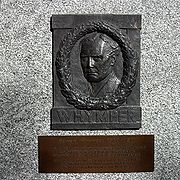
Ecuador
Ecuador , officially the Republic of Ecuador is a representative democratic republic in South America, bordered by Colombia on the north, Peru on the east and south, and by the Pacific Ocean to the west. It is one of only two countries in South America, along with Chile, that do not have a border...
, designed primarily to collect data for the study of altitude sickness
Altitude sickness
Altitude sickness—also known as acute mountain sickness , altitude illness, hypobaropathy, or soroche—is a pathological effect of high altitude on humans, caused by acute exposure to low partial pressure of oxygen at high altitude...
and the effect of reduced pressure on the human body. His chief guide was Jean-Antoine Carrel, who later died from exhaustion on the Matterhorn after bringing his employers into safety through a snowstorm.
During 1880, Whymper made two ascents of Chimborazo
Chimborazo (volcano)
Chimborazo is a currently inactive stratovolcano located in the Cordillera Occidental range of the Andes. Its last known eruption is believed to have occurred around 550 AD....
(6,267m), also claiming the first ascent. He spent a night on the summit of Cotopaxi
Cotopaxi
Cotopaxi is a stratovolcano in the Andes Mountains, located about south of Quito, Ecuador, South America. It is the second highest summit in the country, reaching a height of...
and made first ascents of half a dozen other great peaks. In 1892, he published the results of his journey in a volume entitled Travels amongst the Great Andes of the Equator.
His observations on altitude sickness led him to conclude that it was caused by a reduction in atmospheric pressure, which lessens the value of inhaled air, and by expansion of the air or gas within the body, causing pressure upon the internal organs. The effects produced by gas expansion may be temporary and dissipate when equilibrium has been restored between the internal and external pressure. The publication of his work was recognized on the part of the Royal Geographical Society
Royal Geographical Society
The Royal Geographical Society is a British learned society founded in 1830 for the advancement of geographical sciences...
by the award of the Patron's medal.
His experiences in South America having convinced him of certain serious errors in the readings of aneroid barometer
Barometer
A barometer is a scientific instrument used in meteorology to measure atmospheric pressure. Pressure tendency can forecast short term changes in the weather...
s at high altitudes, he published a work entitled How to Use the Aneroid Barometer and succeeded in introducing important improvements in their construction. He afterwards published two guide books to Zermatt and Chamonix.
Canadian Rockies
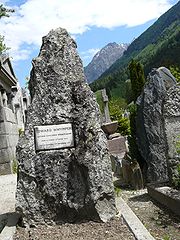
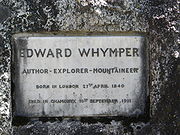
Canadian Rockies
The Canadian Rockies comprise the Canadian segment of the North American Rocky Mountains range. They are the eastern part of the Canadian Cordillera, extending from the Interior Plains of Alberta to the Rocky Mountain Trench of British Columbia. The southern end borders Idaho and Montana of the USA...
several times and made arrangements with the Canadian Pacific Railway
Canadian Pacific Railway
The Canadian Pacific Railway , formerly also known as CP Rail between 1968 and 1996, is a historic Canadian Class I railway founded in 1881 and now operated by Canadian Pacific Railway Limited, which began operations as legal owner in a corporate restructuring in 2001...
(CPR) to promote the Canadian Rockies and the railway in his talks in Europe and Asia. In exchange, the CPR agreed to pay transportation costs for himself and his four guides. In 1901, Whymper and his four guides made the first ascents of Mount Whymper and Stanley Peak in the Vermillion Pass area of the Canadian Rockies. (Confusingly, his brother Frederick
Frederick Whymper
Frederick Whymper was a British artist and explorer.Whymper was born in London in 1838, the eldest son of Elizabeth Whitworth Claridge and Josiah Wood Whymper, a celebrated wood-engraver and artist...
also has a mountain in British Columbia
British Columbia
British Columbia is the westernmost of Canada's provinces and is known for its natural beauty, as reflected in its Latin motto, Splendor sine occasu . Its name was chosen by Queen Victoria in 1858...
named after him
Mount Whymper
Mount Whymper is a mountain located on Vancouver Island, British Columbia. It is the highest point in Canada located south of the 49th parallel and is located between the headwaters of the Chemainus River and the South Nanaimo River north of Honeymoon Bay....
, from his days with the Vancouver Island Exploration Expedition in 1864.)
On 16 September 1911, Whymper died at the age of 71, shortly after another climb in the Alps. He refused medical attention to the point of very death by locking his hotel door.
He is buried in Chamonix
Chamonix
Chamonix-Mont-Blanc or, more commonly, Chamonix is a commune in the Haute-Savoie département in the Rhône-Alpes region in south-eastern France. It was the site of the 1924 Winter Olympics, the first Winter Olympics...
, France.
Illustrator
When not climbing, Whymper pursued his profession as an engraver of illustrations for books and periodicals. Among the books he illustrated was his fellow-mountaineer Florence Crauford GroveFlorence Crauford Grove
Florence Crauford Grove was an English mountaineer and author, sometimes known as F. Crauford Grove.-Mountaineer:Grove became an experienced alpinist in the late 1850s and joined the Alpine Club of London soon after it was formed in 1857, later serving as its President from 1884 to 1886...
's The Frosty Caucasus (1875)
Quotes
-
-
-
-
-
-
-
-
-
- Edward Whymper, Scrambles Amongst the Alps
-
-
-
-
-
-
-
-
Books
- Alan Lyall, The First Descent of the Matterhorn, Gomer (Privately)1997
- Edward Whymper, Scrambles Amongst the Alps, ISBN 0-7922-6923-3
- Edward Whymper, The Ascent of the Matterhorn, ISBN 1-903933-17-X
- Edward Whymper, Travels Amongst the Great Andes of the Equator, ISBN 1-904466-24-9
- Frank S Smythe, Edward Whymper, Hodder and Stoughton, 1940
External links
- Edward Whymper on Peakfinder
- Peter H. Hansen, ‘Whymper, Edward (1840–1911)’, Oxford Dictionary of National Biography, Oxford University Press, 2004

